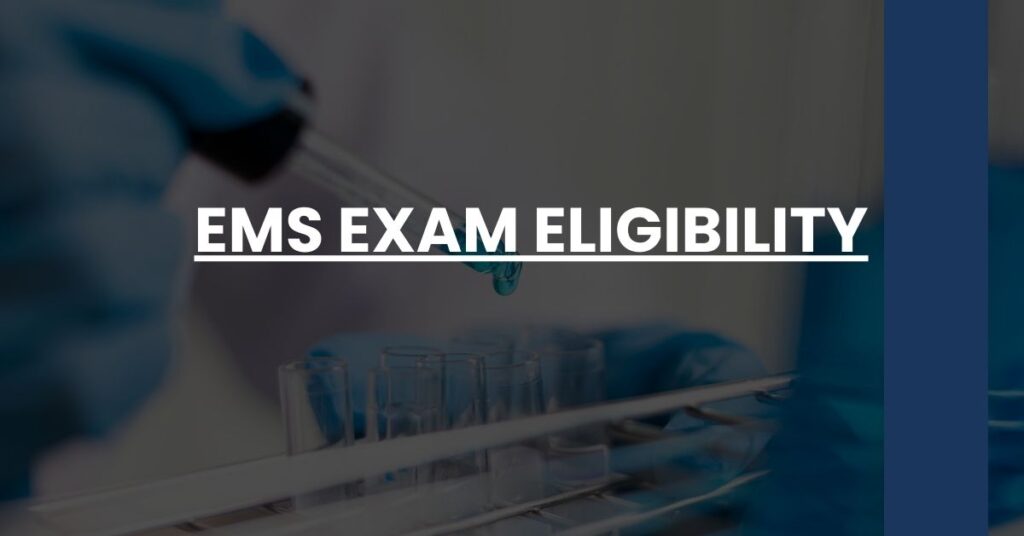Eligibility for the EMS exam requires meeting specific educational, clinical, and legal standards to ensure you’re ready to become an Emergency Medical Services professional.
If you’re looking to certify at any level from EMR to Paramedic, you’ll need to complete the mandated coursework and hands-on experience.
Here’s a snapshot of what you need:
- Approved educational coursework
- Clinical and field experience
- Successful completion of the National Registry exam
This guide will provide you with the precise steps and requirements to ensure your eligibility for the EMS Exam, allowing you to move forward confidently in your career.
- Understanding EMS Exam Eligibility
- The Different Levels of EMS Certification
- Educational Requirements for Eligibility
- Age, Identification, and Legal Prerequisites
- Clinical and Field Experience
- The Application Process for the EMS Exam
- Renewal and Continuing Education
- Special Considerations for Different Applicant Groups
- Conclusion: Preparing for the EMS Exam
Understanding EMS Exam Eligibility
Before you dive headfirst into the life-saving world of Emergency Medical Services (EMS), there’s one hurdle you’ll need to clear: the EMS certification exam. Gaining an understanding of the EMS exam eligibility criteria is your first step towards a career as an EMS professional.
Educational Background and Certification Requirements: Ensuring you have the correct educational background is pivotal. You’re required to have completed the necessary training program specific to your chosen level of EMS certification. Whether you aspire to be an Emergency Medical Technician (EMT), Advanced EMT (AEMT), or Paramedic, each level demands particular educational achievements and certifications.
Board Certification and Fellowships: If you’re aiming for a higher rung on the EMS ladder, such as a specialist role, board certifications, and completion of accredited fellowships can be part of your eligibility trajectory. For detailed insights into the subspecialties and the required pathways, refer to reliable resources such as the American Board of Emergency Medicine.
The Different Levels of EMS Certification
In EMS, several levels of certification reflect the range of skills and responsibilities each role carries:
- Emergency Medical Responder (EMR): This is the foundational level in emergency services; your duties will revolve around providing immediate lifesaving care.
- Advanced Emergency Medical Technician (AEMT): A step above EMT, an AEMT has additional training, particularly in administering medications.
- Paramedic: As the most advanced pre-hospital provider, Paramedics engage in complex patient assessments and provide a higher level of care.
Each of these tiers requires not just specific educational prerequisites but also a passing score on the National Registry of Emergency Medical Technicians (NREMT) exam or equivalent state exams. You can find a breakdown of these distinctions at resources like the Difference Between EMT Certification Levels.
Educational Requirements for Eligibility
Investing in your education is non-negotiable in the EMS field. To qualify for the EMS exam, you typically need:
- A high school diploma or GED.
- Successful completion of a state-approved EMS training program.
Age, Identification, and Legal Prerequisites
Your journey to becoming an EMS professional isn’t just about education and training—it’s also about meeting age and legal criteria.
- Proper Identification: Be prepared to show proof of identification that verifies your age and legal status.
Adhering to these prerequisites verifies your ability to practice as a reliable and trustworthy EMS provider. You want to project an image of responsibility and integrity, which is foundational in this line of work. Check the guidelines provided by the National Registry of Emergency Medical Technicians to gain more insight into these requirements.
Clinical and Field Experience
Gaining hands-on clinical and field experience is a critical aspect of confirming your EMS exam eligibility. In many programs, this is where your education transforms into practical, life-saving skills.
Before you can administer life support or triage patients in high-pressure scenarios, you must first demonstrate proficiency in a controlled environment:
- Field Internships: Field training is typically spent on ambulances or in pre-hospital environments and is essential for understanding the realities of emergency response.
Certification and Evaluation:
Certification providers, like the National Registry of Emergency Medical Technicians (NREMT), will often require documentation of your clinical and field experiences. Institutions such as the Patrick Henry Community College offer insights into these programs, providing a glimpse into the requirements for clinical and field internships.
The Application Process for the EMS Exam
When applying for the EMS exam, staying organized and attentive to detail is essential. You’ve worked hard to meet the educational and experience prerequisites, and now it’s time to compile and submit your application:
- Documentation: Gather your transcripts, proof of clinical and field experience, and any certifications you’ve earned.
- Application forms: Complete all required forms accurately, ensuring no detail is overlooked.
For more assistance with the application process in states like California, the California EMS Authority provides comprehensive guidance.
Renewal and Continuing Education
Maintaining your EMS certification is not a one-and-done deal. To ensure ongoing EMS exam eligibility, you’ll need to participate in continuing education (CE). These educational opportunities enable you to stay up-to-date with medical advancements and refresh your skills:
- Continuing Education Units (CEUs): Accumulate the required number of CEUs within your certification period.
- Refresher Courses: These courses cover critical updates in EMS practice and can also count toward your CEU requirement.
Your eligibility for re-certification and the integrity of your licensure depend on this ongoing commitment to education. In California, examples of acceptable CE include 24 hours of approved EMS CE or an approved 24-hour refresher course, as outlined by the California EMS Authority.
Special Considerations for Different Applicant Groups
Your path to EMS exam eligibility might be influenced by unique circumstances. Perhaps you’re a military service member seeking to transition to a civilian EMS role or an internationally-trained professional needing to validate your credentials in the United States. In such cases:
- Military Applicants: Look for programs that recognize and give credit for your military medical training.
- Foreign-Educated Individuals: You may need to undergo evaluation and complete additional training to meet US standards.
Above all, don’t let these unique circumstances discourage you. They add diversity to the field of emergency medicine and can enrich the care provided to communities.
Conclusion: Preparing for the EMS Exam
Embarking on a career as an EMS professional is a noble and challenging path, and navigating the specifics of EMS exam eligibility is your first significant step. From meeting educational requirements to acquiring hands-on experience, each component of eligibility is designed to prepare you for the realities of this essential work.
As you move towards achieving your certification, lean on reliable resources, engage in continuous learning, and stay committed to the process. With dedication and proficiency, you’ll soon be among the ranks of trusted EMS professionals, ready to make a lifesaving impact in your community.

